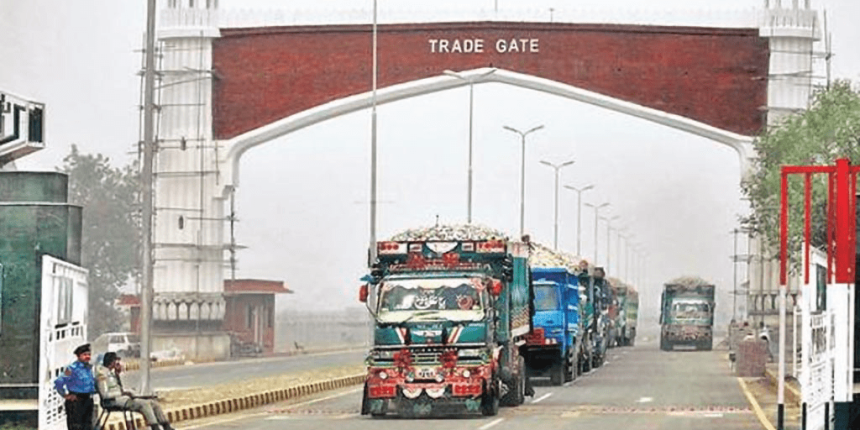India and Pakistan lie in a region that is not only geopolitically crucial but also the most economically under-utilized region in the whole world. The subcontinent has always been historically the self-reliant region when it comes to business, commerce, trading activities and total national output including many other economic parameters. The bitter rivalry between the two neighbors since their birth has, in fact, made the whole region of Indo-Pak stagnant economically and many millions have been suffering heavy financial and social losses in both sides of the border due to the absence of infrastructure and basic facilities.
When it comes to the bilateral trade, it is very interesting to observe that in the very first financial year, Pakistan bought 50.6 percent of her total import commodities from India and earned 23.6 percent of total export revenue from the same neighbor. These stunning figures, in reality, describe the true advantage and potential of the trading relations between the neighbors. Looking at the benefits and convenience, the economic managers from both the newly independent states decided to go further to cement their trading relations with the bilateral trade agreement on August 1952, under which Pakistan was allowed to import 26 goods from India and was happy to export 14 goods in return.
The bilateral trade relations of the neighbors had never been so smooth and consistent as it was always desired. Pakistan also had its share of issues when it comes to having a proper trade relation with any country. The country, unfortunately, had a very volatile political system from its inception. The government system was also very fragile and ineffective that for many good years the country was ruled by handicapped administrators, incompetent politicians, and self-inflicting dictators. Furthermore, the country did not have an easy relation with its neighbor since its independence considering the fact that both neighbors had many pressing issues like Kashmir Dispute, Water & River Conflicts, Sir Creek Issue, and Border Rivalry among others. These issues compelled both countries to have trade boycotts, sanctions, surging tariffs, and embargo and discourage smooth trading relations.
Both neighbors, at present, do not have any trade agreement. Being a member of WTO and SAARC, both countries are bound to give Most Favorite Nation status to each other. India being WTO member gave Pakistan the tariff concession. Under the above-mentioned platforms, both countries were allowed to have Free Trade Agreement and/or Preferential Trade Agreement but this never happened with both nuclear nations. The retaliatory policies from both countries never allowed having any sort of trade agreements.
India and Pakistan, currently, have a very marginal official trading relation. The total trade between the neighboring nations just accounts for $2 billion at the end of June 2018. It is also interesting to observe that India has the second largest populated country in the world aggregates almost 18 percent of the world population. The Indian nominal GDP accumulated $2.166 trillion by the end of 2018-2019 financial years which is the sixth biggest economy in the world. On the other side, Pakistan is the sixth most populous country in the world with $313 billion GDP crossed in the financial year of June 2018 and ranked among the top 25 economies in the world. Both countries almost account for 20 percent of the total world population. Considering these facts, it is actually believed by many global economists that there exists around $37 billion trading potential between the two nuclear-armed arch rivals if both neighbors open their respective trading doors towards each other.
It is in fact extremely disappointing to observe that both these countries being neighbors do not prefer to have healthy trade relations with each other. It is also very sad to know that both the nuclear-armed countries purchase and sell each other’s commodities and goods from third countries like the UAE and Singapore among many. This not only evades all the trade revenue from the respective countries but also makes all the imported commodities more expensive and delay supply. Furthermore, many countries even love and take full advantage of this rivalry and have established strong trade relations at the cost of either Pakistan or India.
Similarly, smuggling has always been a painful issue for both the nations as their porous-border always gives space for illegal elements to smuggle commodities and goods from both countries. Soon after 911 incidents, the smuggled Indian goods and commodities have found its new way in Pakistan via Afghanistan. It is due to this very reason both countries do not fall in the top ten trading nations on their respective country lists.
As far as the economic structure of both nations is concerned, the two nations since independence have always been the closed economies. Throughout all these years, they both have been discouraging to open their respective economies for level playing field at the international arena. Since the advent of WTO in 1995, both countries have been compelled to open their economies for the world which make ways for foreign goods and commodities to find their ways in both Indian and Pakistani markets. Since India has been following the consistent and stable political system with some of the best economic managers available like that of Dr. Manmohan Singh, it has already improved its basic economic infrastructure along with numerous industries and it is now exporting some of the best high-end finished goods and services.
As far as Pakistan’s economic conditions are concerned, it always has a very weak and fragile political system. It also has some of the absurd and incompetent economic managers throughout history who keep on changing the economic policies without ever establishing the industrial base or economic infrastructure. It is disappointing to note that the only sector ‘the textile sector in Pakistan’ which has always been considered the backbone of the country’s economy has been running on Government Subsidies for as many years. It is in spite of those subsidies that not a single textile company is able to produce world-class industrial output or finished goods. This is the same case in many economic sectors of the country which is why almost every locally manufactured good is not able to compete even in the Pakistani market due to lack of quality and up gradation.
The bilateral trade of Pakistan with India if fully opened would find the same equation as that of Chinese trade with Pakistan. The country has been consistently facing the trade deficit with China for many years and the country’s goods are not fully at par to play in a level field. It is due to this reason, Pakistan imports more goods from China and sells less in return. India, at present, has some of the best-finished goods, commodities, and services in the world and these same are competing with that of Chinese commodities, goods, and services. Pakistan at first place needs to review its economic policy. It must industrialize its economic base and try to develop an R&D mechanism in every economic sector. This will expedite the quality of industrial outputs in the form of best-finished goods, commodities, and services in accordance with the international standard. These steps will not only open new export markets for the country but also reduce the surging trade deficit with every other country.





